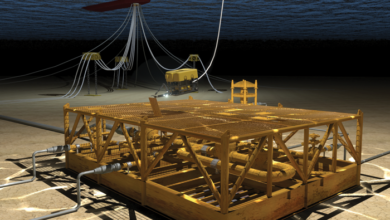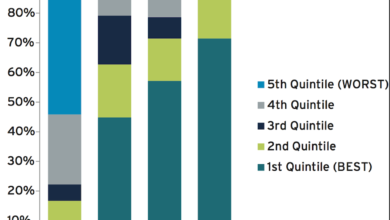Solids control automation on the horizon with autonomous shaker, ultrasonic sensor in development
Innovations also target improved drilling efficiency, maximized fluid recovery
By Alex Endress, Editorial Coordinator
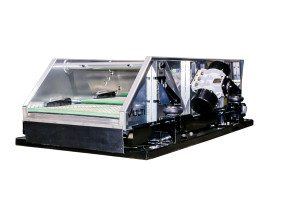
If clean drilling mud is the life-blood of a drilling operation, then controlling the buildup of cuttings and solids inside the wellbore is paramount to maintaining its well being. But how well is the industry cleaning its drilling mud to feed back into the wellbore and ensure an optimized drilling operation? Some would argue that we don’t know – at least, not in as much detail as we should. As much as the industry has automated other parts of the rig and the drilling process, solids control equipment and process remain primarily manual. Technology advances under development may signal changes in the near future, however.
Two in particular – an ultrasonic sensor that takes real-time measurements and an autonomous shaker that operates without human intervention – are being designed to push solids control automation forward. These are coming alongside other advances that address operator needs to drill longer and deeper horizontal sections, as well as economic needs for further cost savings by increasing fluid recovery and producing drier cuttings. As with most technical innovations in this industry, the challenge will be to get these new technologies adopted into the field.
“There are all kinds of brilliant breakthroughs that are being made, but to get them in the field is a huge step from just proving it in the lab,” Dr Leon Robinson, former Research Advisor of 39 years at Exxon Production Research, said. Dr Robinson, who serves as Chairman of the IADC Technical Publications Committee, recently coauthored IADC’s Drillers Knowledge Book, a practical guide to avoid drilling problems, with retired ExxonMobil Worldwide Drilling Manager Juan Garcia.
For companies that may be reluctant to consider new solids control technologies, Dr Robinson urged them to take closer looks at how solids control is affecting their drilling performance, in both visible and invisible ways and in both water- and oil-base drilling fluids. “If you’re not getting cuttings off the bottom, the bit is regrinding the same cuttings over and over and can’t drill as fast. It looks like the rock is hard, but it is not. It is an inability to get the cuttings off the bottom of the wellbore,” he said. “You’re going to have a lot of torque and drag. You might think you are putting 30,000 lb of weight on bit, but you may be only putting 15,000 lb of weight on the bit because you’ve got 15,000 lb of drag force keeping you from putting that weight on the bit.”
Ineffective solids control efficiency can be the culprit in many common NPT events, such as lost circulation, stuck pipe or well control incidents. “Excessive drilled solids are detrimental to a mud system at so many different levels,” Jason Norman, Chief Operating Officer at Zaxxon Instruments, said. “It is common that we actually induce lost circulation because we are unable to effectively treat the drilled solids in the mud system. Even more serious is once you are in a lost-circulation mode, you’ve emptied your annulus of fluid, and all of a sudden you could take a kick because you don’t have any barrier of mud in the hole.”
Mr Norman suggests that the industry needs to explore for ways to more efficiently quantify the correlation between solids control and drilling efficiency. “Seasoned vets on the rig drill with terms like ‘rule of thumb’ or ‘gut feel’… but imagine the possibilities if they had more information,” he said. That might include data on density, flow rate, particle size distribution and rheology – all in real time. Being able to measure the effectiveness of solids control equipment in real time would allow operators to run real-time hydraulics models, as well as real-time dilution economics and solids control efficiency evaluations, such as centrifuge efficiency, shaker screen efficiency, sweep efficiency and mud pump efficiency. “You can do all these things right now, but everything is done manually. It is done as one snapshot in time,” Mr Norman said.
Utilizing Coriolis meters can certainly help, but Mr Norman estimates that less than 5% of all rigs are equipped with these devices. Cost could be one reason, as installation requires cutting into the rig to mount the flanges, which hold the meter in place.
One possible solution, still under development, could come in the form of a clamp-on measurement tool that measures real-time fluid density, flow rate, particle size distribution and rheology using ultrasound. The Rheopipe, in development by Zaxxon since summer 2013, is an ultrasonic sensor that can be attached to the outside of the pipe. The final version of this development will have the ability to measure both a full pipe and a partially filled pipe.
“We could put this instrument on the flowline, on the suction side of the centrifuge and on the effluent side of the centrifuge, then measure the efficiency of the solids being removed,” Mr Norman said. This allows the efficiency of the shale shakers and centrifuges to be quantified because the mud is measured both before and after it goes across these machines. Zaxxon got the idea from similar tools being used in other industries to measure flow rate, such as the food processing, chemical manufacturing and cosmetics industries.
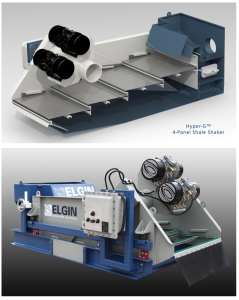
Initial flow loop tests sponsored by Shell were conducted in Houston and have already proven the sensor’s capability to read data through the pipe, according to Zaxxon. An additional flow loop test scheduled for November will use the flow loop to test the sensor on drilling mud and determine its effectiveness at measuring fluid density, flow rate, particle size distribution and rheology. “At this point, we are getting some good results with the clamp-on transducers through a schedule 160 pipe, but the data is rather noisy. The signal processing needs to be amplified, and the transducers need to be more powerful.”
If the sensors’ efficiency can be proven, Mr Norman estimates that a small land rig would need six to eight of the ultrasonic devices, and a deepwater drillship would likely need 20-30. Since the sensors would be attached externally without any welding, they could be used on both new and older rigs. The sensors would be installed with an independent and external PLC to decipher data from the sensors and would transfer data from sensor transmitters to the PLC through wireless gateways. “We could clamp it on your standpipe, each of your mud pumps, your suction line to your centrifuge, the discharge line to your centrifuge, flowline… It would measure these properties no matter where you put it,” he said. The PLC would connect the real-time data to the operator’s network, which could be accessible by anyone from rig crews to office workers, if necessary. One holistic sensor system integration will allow us to use fewer sensors and still capture all the necessary data we need to provide a totally optimized drilling fluids process.
Zaxxon asserts that these ultrasonic sensors can provide a window into invisible lost time, utilizing a more automated process to help operators understand what is really necessary to increase drilling efficiency through solids control technology. “If you look at every other industry in the history of time that went down the road of automation, nobody got halfway down the road and turned back and went back to manual methods,” Mr Norman said. “Our industry will be no different. It is just slow to warm up right now.”
Smarter automated shakers, multiplied G-force
Almost every standard flowline shale shaker on the market today exerts approximately 6-8 G’s on the drilling mud. Much more than that could structurally damage the shakers’ vibrating baskets, Fluid Systems President Ben Hiltl said. “The issue with all the (standard shakers) out there, including ours, is how much input we achieve with the vibrating basket and how much energy we actually get to the drilling mud,” he said.
While these shakers can reliably separate drilled solids from mud as a first line of defense, they may not be enough to address operators’ increasing focus on waste management to meet today’s environmental standards, such as EPA 9095B, Mr Hiltl asserted. Additionally, the industry downturn means operators are looking for ways to recover more valuable drilling fluid that can be reused.
A variety of additional equipment can be used to achieve these goals. These include centrifugal cuttings dryers or drying shakers, which may use finer mesh screens. However, Mr Hiltl notes that these drying shakers don’t exert any more G’s on mud than flowline shakers.
At this year’s OTC, Fluid Systems commercially launched the MultiG shaker, which can exert up to 50 G’s on drilling mud, according to the company. Initially driven by support from Chevron as the operator sought ways to achieve drier cuttings, the shaker was first designed as a drying shaker but can also be used as a flowline shaker or mud cleaner.
The machine adds a series of patented “exciters” underneath the screen panel that increase G-force on the screens as the shaker vibrates. The exciters swing back and forth through an elastomer connecting the weights to a “beater,” which is attached underneath the screen panel. As the vibrating basket of the shaker exerts G-force on the screens, the exciters multiply the G-force the shaker applies onto the screen panel. “The shaker vibrates, and (the beater) just starts swinging harder and harder,” Mr Hiltl said. “The high G’s are applied only to the screen panel surface, not the machine.”
While both the MultiG and a standard shaker usually operate at 1,800 rpm, the exciters can increase the G-forces exerted on the drilling fluid from 8 to 50 G’s, according to Mr Hiltl. However, the MultiG can also vary the G-force intensity per every cycle through a variable frequency drive (VFD), while standard shakers remain constant. This allows the new shaker to create multi-frequencies, as G-force cycles are accelerated and decelerated repeatedly to avoid screen blinding – when small solids become lodged in the openings of the shaker screens, reducing volume handling – which is a risk with constant frequency shakers.
Frequencies on the MultiG range from 30 hertz to 1 kilohertz, and the range of G-forces exerted can be adjusted. For example, an operator can increase the G-forces exerted on the screen panel to a desired range, such as 30-50 G’s, through the VFD.
The exciters on the shaker were adopted from a patented mining technology that is being used by a Fluid Systems joint venture company, FSIVIRTO. The JV company uses the same type of exciters that are used on coal mine screens, which function similar to shale shakers on drilling rigs.
This summer in the Eagle Ford, the MultiG was used in a field evaluation run to demonstrate its capabilities to achieve drier cuttings. Over a period of 13 days, the new shaker worked alongside an older FSI shaker, model 5111BLE. The MultiG was able to decrease oil on cuttings by 50%, according to the company.
Looking to the future of shale shakers, Fluid Systems has its eyes set on full automation. Mr Hiltl compared the automation of today’s shakers to what could be found in an old 1980s car. There are no shakers that can incorporate intelligent feedback to automatically control the shaker without human interaction. “Right now, standard shakers require an attendant. They are still dumb iron,” he said.
Fluid Systems is developing a shaker that would operate on its own, using data from real-time measurement tools – such as sensors that measure density, flow rate, particle size distribution and rheology – without the need for human interaction. “This technology is basically controlled by algorithms, and it gets data input from the rig.” He likened it to an automobile that can parallel park without driver interaction.
“The ProdiG is capable of receiving data from flow meters or in-line mud properties, such as plastic viscosity, mud weight and particle size distribution, to adjust itself – maximizing flow rate capacity and minimizing liquid retention. It will have internal sensors to monitor motion, G-force, vibration angle, deck angle, frequency and instantaneous weight of material on the screens.”
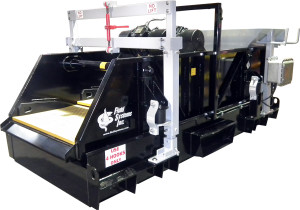
Under development since 2013, the shaker would use 24 real-time channels of data input, such as mud flow rate, density, rheology and ROP, to automatically adjust the shaker settings, such as frequency, G-force and conveyance rate. The adjustments would be controlled by an internal computer (PLC), which would be programmed with algorithms to optimize shaker performance. Data from the computer is used to control the motors that control the shaker’s motion. “All we’re doing is programming it so it recognizes what to do with certain conditions,” Mr Hiltl said. He indicated the company is still working on the algorithms that will run the shaker’s computer.
The ProdiG will incorporate a feedback control similar to a cruise control system in a car, for example, that matches a target conveyance rate. The shaker would also be able to detect holes in screens. Ideally, screen replacement and other routine maintenance would be the only time the shaker needs human intervention, Mr Hiltl said. In case of technical malfunction, such as a software malfunction, the shaker can be manually operated. Diagnostics of the shaker’s performance would also be transmitted from the shaker’s internal computer to the driller’s console.
Mr Hiltl said the shaker would work best on rigs that are equipped with data acquisition but that it also could work as a standalone shaker. “If you have a rig that actually has no data acquisition whatsoever and this is just a standalone machine, you can program the shaker to react on certain inputs, but not the full extent.” In this instance, the shaker would rely only on properties read through the shaker’s internal sensors, such as flow rate and mud weight, or externals sensors added onto the rig after its initial construction.
Fluid Systems is targeting a December 2015 field test for the ProdiG that would take place in South Texas. The goal is to prove the shaker can work autonomously without human interaction during the drilling process. A mid-2016 commercial launch is planned.
It would be available as a flowline shaker and drying shaker for both onshore and offshore applications. Aside from the computer programming, there is no ongoing design work to be done on the ProdiG’s parts, as it would be mechanically identical to the company’s other standard shakers.
Improving solids control through reliability, flexibility
For Elgin Separation Solutions, reliability was the No. 1 goal during the design of the Hyper-G dual-motion variable speed shaker, launched at OTC this year. “Operators are drilling deeper, faster and longer. They need equipment that can handle these conditions, and equipment that can’t handle these conditions becomes unreliable,” Elgin President Michael Rai Anderson said. “When it comes to solids control and drilling fluid management, the fundamental goal is management of colloidal solids – doing everything you can to minimize the volume of colloidal solids that build up in your drilling fluid.”
The second goal was flexibility. “(Operators) want one piece of equipment to be able to handle multiple variables,” Mr Anderson said.
The new four-panel Hyper-G shaker is available as a flowline or drying shaker. Since a prototype model was launched last year, the company has incorporated several improvements into the design, including a single-point jacking system, a patent-pending cascade waterfall design for the screens to protect rear flowline gaskets, and a redesigned control system, allowing for ease of G-force and motion control.
Mr Anderson said the shaker’s jacking system has two bearings that are used at the fulcrum of the pivoting arms and two 2,000-lb gear jacks with a tether between them. The jacking system can adjust shaker basket angle for better separation, using a rotating hand-wheel near the rear side of the possum belly as fluid travels over the shaker screens. “Instead of having a complexity of gimmicks of the mechanisms that operate things, we just went ahead and created a very simple item that can achieve the same thing” as more complicated jack systems – which is to raise and lower the angle of the shaker basket, Mr Anderson said.
The simplified jacking system also “has very few things that can potentially break on it,” he explained. The only breakable piece is the screw jack, which has a one-year life expectancy on most standard shakers. However, because of how the jacking system is designed – with no overall weight applied to the screw jack, Elgin expects the Hyper-G’s screw jack life expectancy to be about five years. Replacement could be done within 15 minutes if the part is onsite. No proprietary bolts or fasteners are required for repairs or maintenance.
To increase reliability, the patent-pending Screen Cascade Waterfall Technology has been added. This is a series of overlapping screen decks holding each screen on the shaker basket, which allows drilling fluid to continuously flow to the next screen without direct contact with the screen gasket. “The ultimate goal is that it reduces wear on the gasket, which could lead to solids contamination back into the active tank. One of the major areas where solids bypass is created is behind the screen between the shaker basket and the gasket,” Mr Anderson said. “What we’ve done is designed the shaker so that the solids – when they’re coming across the shaker – don’t actually touch the back side of the screen or the gasket.”

The waterfall technology protects each screen’s seated position, allowing drilling fluid to fall on the overlapping screens past the position of the rear gasket, according to Elgin. This vastly decreases the possibility of solids being driven down between the screen gasket and the shaker basket, bypassing the screen, Mr Anderson said. By shielding the shaker’s rear gaskets from drilling fluid, this waterfall system is able to extend the life of these screen gaskets, he indicated.
The most flexible new piece of equipment on the shaker is a redesigned Variable-G VFD Control System, which was developed to better control on-the-fly changes in G-force, linear motion and balanced elliptical motion. With a maximum flow rate between 750 to 1,000 gpm, the shaker’s G-force can now be adjusted to between four, six and eight G’s of force without needing to shut off the shaker. Additionally, motion can be toggled between linear motion and balanced elliptical motion without the need to stop the flow of drilling fluid.
In a fall 2014 trial application in the Marcellus, the Hyper-G showed 30% improved drilling fluid capture, as well as reduced 50% maintenance costs, over a standard three-panel shaker, according to Elgin. The new shaker was measured against Elgin’s standard model for 90 days.
Pneumatic vacuum system for fluid recovery
Drilling fluid is an expensive commodity, costing up to $300/bbl. Yet, everyday a significant amount of this valuable fluid is left on drilled cuttings that are discarded as waste. Even with advances in the flowline shaker – including multiple motions and higher G-forces – they are still limited in their ability to completely separate drilling fluid from cuttings.
“There are residual fluids on the cuttings themselves, and some fluid also goes off at the end of the shaker as a result of the fluids just sticking to the screen,” said Calvin Carter, Business Development Manager for M-I SWACO, a Schlumberger company. “It has a surface tension, so it’s difficult to separate that fluid or break that surface tension.”
A typical strategy to reduce the amount of drilling fluid left on discarded cuttings downstream from the shale shaker is to use a vertical cuttings dryer. “It has a large footprint, a lot of moving parts, expensive to operate and requires manpower. A lot of land rigs will choose not to use it,” Mr Carter said. Further, the auger system used to convey cuttings from the shale shakers to the cuttings dryer can pose significant HSE risks, he added.
To address these challenges, M-I SWACO launched its SCREEN PULSE Fluid and Cuttings Separator in April. The pneumatic system can currently be retrofitted onto two shale shaker platforms – the M-I SWACO MONGOOSE PRO series shale shakers and the National Oilwell Varco King Cobra series shale shaker. In the near future, designs will be made available to retrofit to additional single and multi-deck shakers, Mr Carter said.
The components of the SCREEN PULSE system are a small control panel and composite pans. The composite pan is dropped into the shale shaker under the last screen in the shaker bed on the discharge end of the shaker; installation does not require any welding. The vacuum-assisted technology uses compressed air either from the rig supply or a standalone air compressor, which creates a suction that works to “break that surface tension and pull the residual fluid off the cuttings,” Mr Carter said. The suction can be set to pulse on and off through the control panel in a manner to allow cuttings to continue traveling over the shaker.
“By doing that, we’re able to pull the fluid off the cuttings and off the screen surface, and that fluid flows back into the shaker and returns to the active system.”
In 2014, the SCREEN PULSE was used during field trials in the Woodford Shale basin. The operator wanted to lower the costs of managing a high volume of oil-based cuttings generated during the drilling of a 12,500-ft OBM section and the loss of drilling fluid to the cuttings. Before using the M-I SWACO solution, the company was utilizing a cuttings processing package that included a mobile vertical cuttings dryer and centrifuge. The system was used to recover drilling fluid and dry the cuttings for transportation at $8.50/ft.
With SCREEN PULSE, the operator was able to reduce its cumulative drilling waste management costs by $106,250. The technology also helped to recover an additional 285 bbl of OBM that was reused in the active drilling fluid system in the same 20-day OBM section. This saved the operator an additional $45,600 in drilling fluid, according to M-I SWACO.
Click here to watch a video with Jason Norman about solids control automation.
Click here to watch an interview with Fluid Systems’ Ben Hiltl about the MultiG shaker.
Click here for details about the Drillers Knowledge Book.


